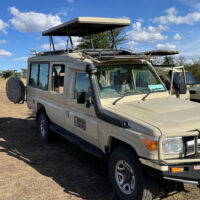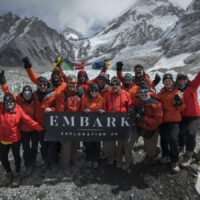A detailed analysis of what to bring for your climb
Climbing Kilimanjaro:
Gear Considerations
06.16.2017

A wise man once said that “Climate is what you can expect, but weather is what you get.”
On Mt. Kilimanjaro, you can certainly expect some weather! Your eight-day trek to the roof of Africa will take you through five distinctive ecosystems, each with differing weather and temperature, from tropical to arctic. In order to feel comfortable and prepared for these changes, even if you have been hiking for years, you may need a complete re-think of the type of clothing you will bring with you to Tanzania. When hiking in temperatures that could range from 90 degrees Fahrenheit to below freezing, having the proper clothing is important – but even more important is just how you should layer that clothing so it performs to its maximum value.
A hiker’s attire is all about practicality, with substance over style. You will need items that will keep you dry when it’s wet, warm when it’s cold and cool when it’s hot. Think breathable, comfortable, lightweight, durable and affordable. Proper technical outdoor attire does not cost; it pays!
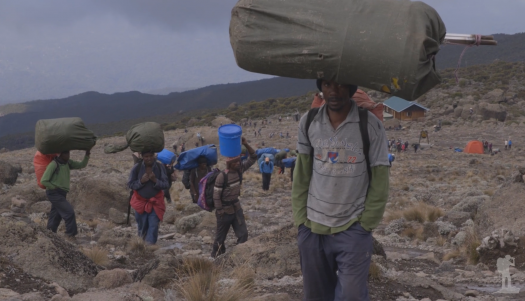
Embark highly recommends that all your trekking attire be made of synthetic material. None of your clothing should be more than 50% cotton. Synthetic material is better at absorbing moisture without becoming heavy or uncomfortable, and it goes a long way in keeping you warm during your hike. If wet weather strikes, soaked cotton clothing will weigh you down and contribute to hyperthermia. Cotton is hydrophilic, meaning it transfers sweat from your skin to the material itself, thus it’s horrible at “wicking” wetness away from skin. In fact, cotton attracts moisture and will become damp simply when exposed to humid air. Once wet, it feels cold, loses 90 percent of its insulating properties, is difficult to dry out, and wicks heat from your body 25 times faster than when it’s dry. Synthetic fabric lessens the heavy chilling effect caused by cotton, plus it’s lighter – not only when you are wearing it, but also when your porter is carrying your extra clothing up the mountain in your duffel!
Layering
Layering is a relatively simple concept. All it involves is combining a few pieces of outdoor clothing in such a way that they can be quickly and easily adapted to a variety of weather conditions and your level of activity. Your daily trek will start in the damp cold of early morning, then blossom into warm and sunny days – but the skies might open up in the middle of your hike with rain, snow or even hail! While walking on the trail, you will be generating plenty of heat, but once you stop moving you will begin to get cold. An appropriate layering system keeps you comfortable in all of these situations.
There are three parts to a layering system: a base layer, an insulating layer and an outer shell.
Base layer
The function of the base layer is primarily to wick moisture away from the body so it can evaporate, keeping your skin warm and dry. A base layer is integral to staying comfortable in the outdoors. Embark suggests that you have two base layer choices; a lightweight one and a heavyweight one. Make sure they are sized properly so that on summit night you can wear both together comfortably. Your base layer can also perform double duty and be used at night as sleepwear. Synthetic fabrics such as polyester (or polyester blends) are preferable, however Merino wool offers more warmth than synthetic material of the same thickness, and it is still comfortable on warm days.
Insulation Layer (mid-layer)
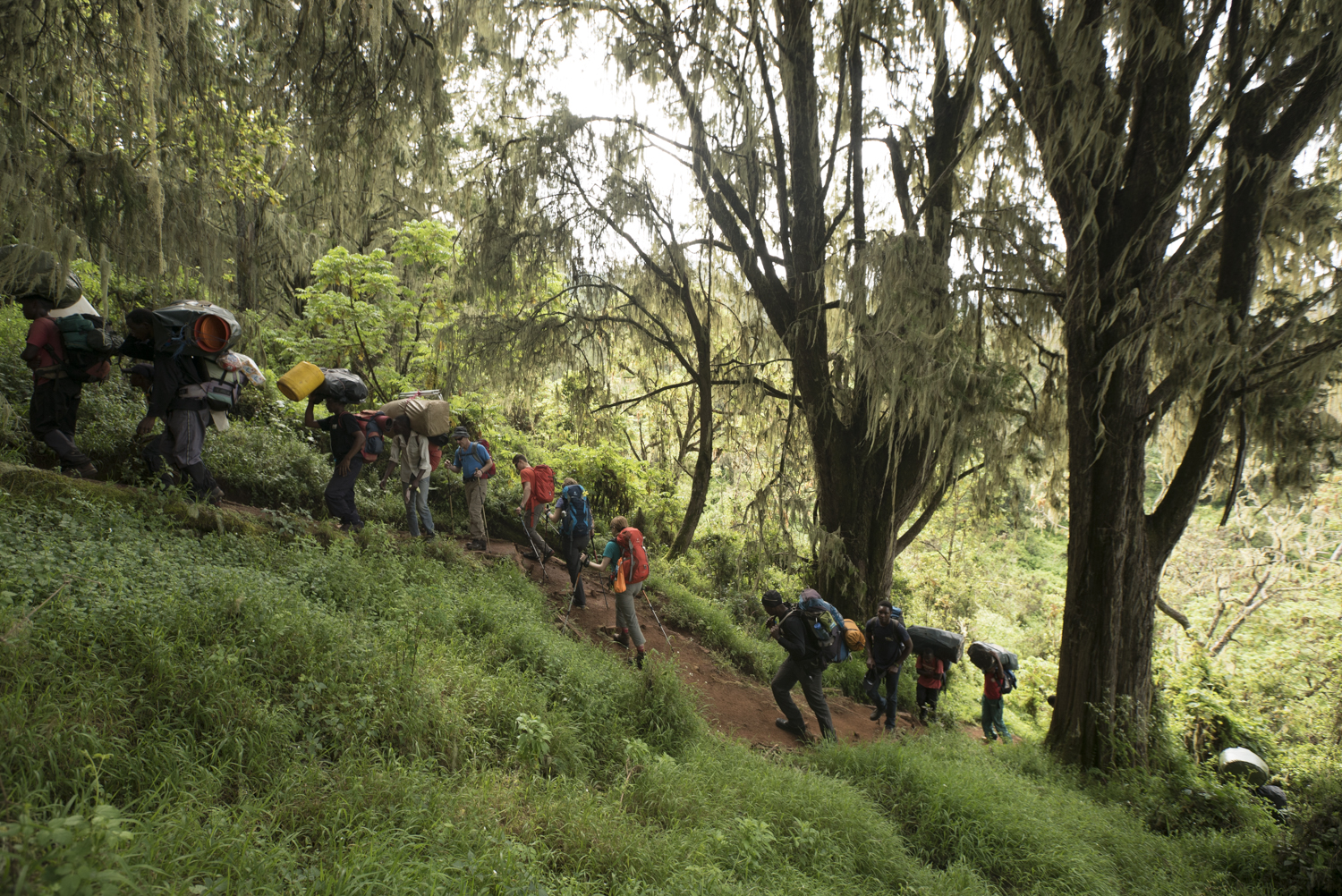
Your base layer retains warmth, depending on how heavy it is, but thermal insulation isn’t its primary function; that’s what your mid-layer is for. The mid-layer can be a fleece pullover or synthetic insulated jacket, both of which retain heat by trapping warm air close to your body. Down insulation is the most compressible and the warmest, but it must be kept dry, while synthetics aren’t quite as thermally efficient as goose down but they insulate better in damp or sweaty conditions – and they cost less. Make sure your insulation layer is large enough to fit over both your lightweight and heavyweight base layers when you wear them together.
Hard Shell
Your shell jacket is the all-important protective layer in your system; this thin jacket must be totally waterproof and totally windproof. The key here is a waterproof/breathable fabric that allows water vapor and heat to escape the jacket as you perspire. If sweat and moisture build up on the inside of the jacket, you’ll end up wet even if it’s effective at blocking precipitation from reaching your body, which defeats the purpose. It is important that your shell layer can compress very small and weigh very little so you can carry it with you every day in your backpack. Plus it needs to be large enough to fit over your double base layer as well as your insulating mid-layer.
Even though your hard shell jacket is waterproof it does not replace the need for a good rain coat. The point of a hard shell jacket is essentially meant to be miles ahead of a raincoat in that it becomes part of your total moisture management system. Hard shell jackets are often a puffy outer insulation shell intended to be worn over your clothing when it’s cold out or you are standing still, while a rain jacket is only used for rain protection, not for staying warm or for shelter from the wind.
If you need a jacket for wind protection, warmth or during everlasting rain, you will need a hard shell. Most rain jackets have little breathability, so if you had to wear it all day long while hiking you would get incredibly clammy and sweaty. A hard shell has better breathability and you can wear it pretty much all the time without being too uncomfortable. So in short, keep your rain jacket in your day pack in case rain is a possibility; it’s light and packable. Your hard shell is worn when it is going to rain all day, or when it’s cold or windy out.
Rain Gear
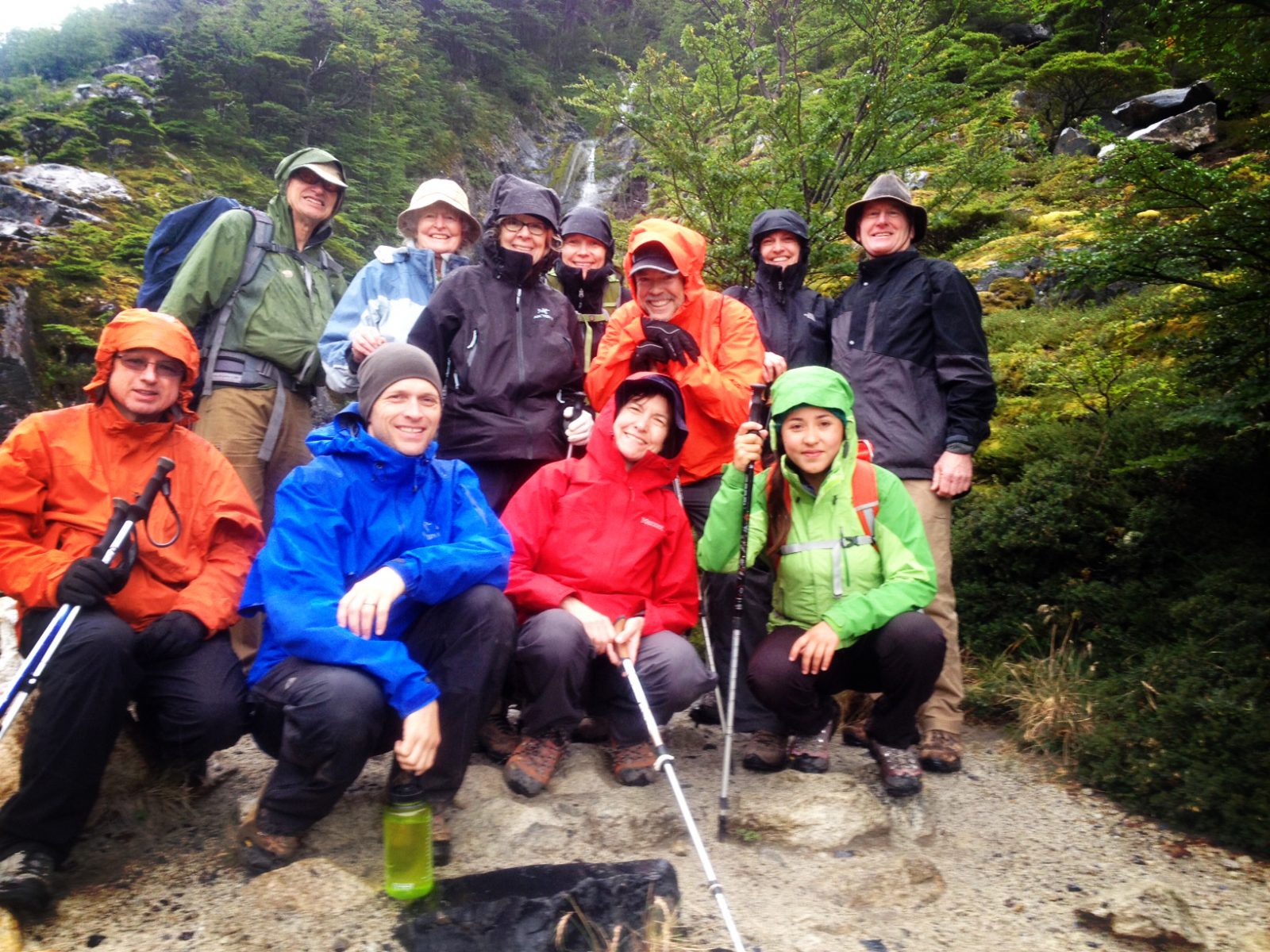
An important component of your layering system is proper rain gear – meaning both a jacket and pants – which when used together with your layering system will ensure you stay dry, safe and comfortable during inclement weather. The key component of your rainwear fabric is a coating or membrane that does the technological trick of blocking rain while also allowing sweat vapor to escape. Because it’s relatively delicate, a membrane will be bonded to a protective fabric to create a laminate. Almost all rainwear is made using either a laminate or a coating, though the exact materials in each will vary. You can choose the style and decide on a cost, but be sure to size it properly so it can fit overall all of your clothing when layered properly. Some hikers like an oversized poncho, one that will cover your upper body as well as your pack; but remember while a poncho is a great option, it will not cover and protect your lower legs from getting wet, so rain pants are always a must.
On your Summit night attempt, your Embark guides highly recommend you dress in five layers: two base layers, light and mid-weight; one insulation layer; a hard shell layer; and finally an outer waterproof layer. It is important that all the clothing you select is large enough to be worn together in this manner.
Socks
Much like your footwear, the socks you wear on the hiking trail can also have a significant effect on your comfort. Your socks should be made of synthetic materials that enhance moisture-wicking performance – and absolutely not made of cotton! For your Kilimanjaro climb, you will need several types of socks. On summit night, you will likely want to wear several pairs, so just like your clothing, make sure you are able to layer your socks.
You might consider the following sock styles:
- Lightweight hiking socks: These socks are best for warmer conditions, stressing moisture wicking and comfort over warmth. They are relatively thin, yet are warmer and provide more cushioning than just sock liners alone.
- Mid-weight socks: These provide cushioning and insulation in moderate to cold conditions, with adequate padding built into high-impact areas like the heel and the ball of the foot.
- Mountaineering socks: Mountaineering socks are the thickest, warmest and most cushioned socks available. They are designed for long trips, tough terrain and cold temperatures.
Liners
Sock liners are thin, lightweight wicking socks designed to be worn right next to your skin. These liners wick sweat away from the surface of your foot to keep you dry and comfortable. Liners also limit the amount of abrasion between your outer sock and your skin. They are designed to be worn under other socks.
Gloves
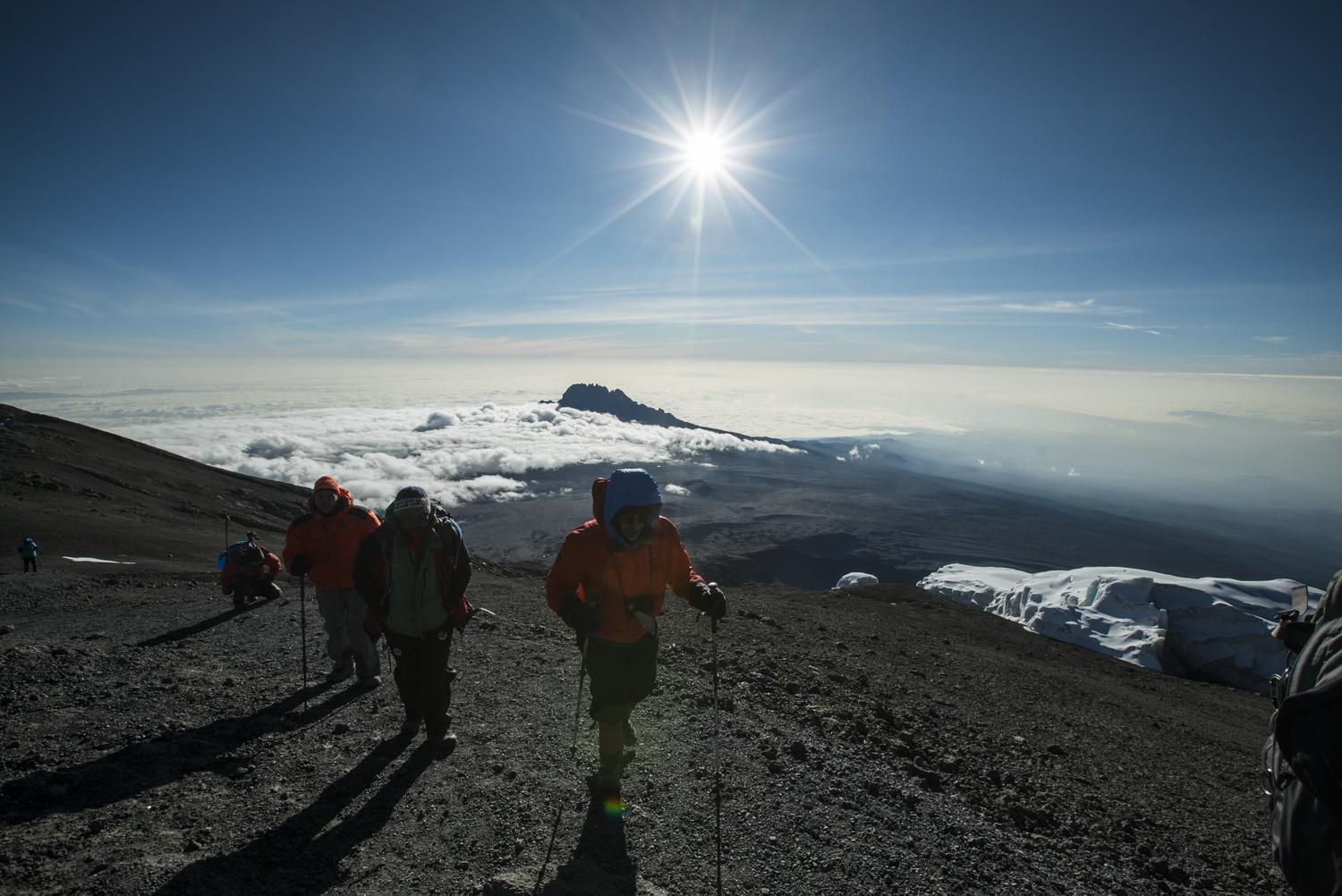
Gloves must be a component of your clothing system and provide an important level of protection and comfort when you hike in adverse conditions. You should bring multiple pairs that can be combined as needed.
- Fleece gloves are a great base layer glove because they stay warm when wet and because your body-heat can dry the perspiration that accumulates in them while you are hiking.
- Thin gloves also help preserve your manual dexterity, allowing you to open zippers or take photos with your camera.
- Oversized rain mitts can be added to your glove system and are worn over fleece gloves. These act as a wind barrier and help retain warmth.
- Summit gloves are the ones you will be wearing to the top of Kilimanjaro. These are over-sized, usually waterproof/breathable gloves that often come with a very warm, insulated glove liner. These gloves can also be worn over one of your higher breathability gloves, even if they’re wet or damp, and will still provide insulation for your hands
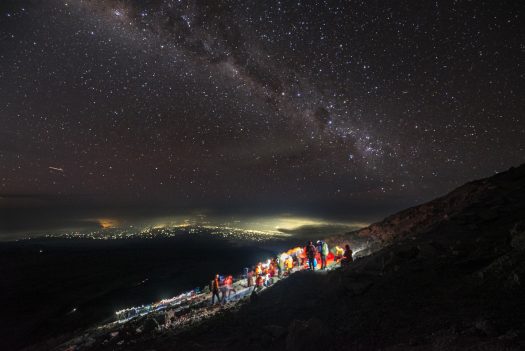
(courtesy of Marty Murphy)
Head Gear
On your Kilimanjaro trek you will need several types of head gear. You will want one hat that shields you from the harmful effects of the sun and provides you with 365 degrees of protection, such as a sun hat or baseball style cap, and a second that provides warmth, such as a ski cap or beanie.
Wool hats tend to be warmer than synthetic, fleece, or acrylic ones, but many people find them itchy. Synthetics dry faster when they get wet and weigh a few ounces less, but unless they have a soft-shell outer layer, the wind can whip right through them. Hybrid wool and synthetic hats are very popular and combine the best features of both.
Another option is a balaclava. A balaclava or ski mask is a form of cloth headgear designed to expose only part of the face. Depending on style and how it is worn, only the eyes, mouth and nose, or just the front of the face are unprotected.
We also suggest you bring along a buff or bandana to use as a head covering, a neck gaiter or as a personal hygiene item.
And to round out your headwear, bring a headlamp — here are details on that.
Gaiters
Snow, water, dirt and pebbles have a way of getting into even the most waterproof of boots. To prevent this from happening, consider using some type of gaiter. Gaiters cover the vulnerable tops of your footwear to fully protect your feet from the elements. Gaiters come in many styles, but we recommend a waterproof, knee high style.
Hiking Boots

In order to safely participate in your many practice hikes, as well as perform to your potential on Kilimanjaro, you must have a pair of appropriate hiking boots that fit you properly, provide adequate ankle support, and are comfortable and waterproof. Your boots may be the most important bit of equipment you bring with you, so it is very important that you research what brand and fit works best for you.
Embark highly recommends shopping for your boots at a reputable outdoor store, one with a knowledgeable sales staff who can assist you with fit, form and function of your potential new boot.
There are three key characteristics to look for in a pair of trekking boots: fit, quality, and function. Let’s deal with each characteristic below:
Fit
The best way to test good fit is while wearing your hiking socks, place your foot in the boot and slide it all the way forward until your toes hit the front of the boot. Then take your index finger and slide it down the back of the boot between your heel and the boot support. A perfect fitting boot will allow you to squeeze your finger in without too much resistance. If you cannot squeeze your index finger down the back of the boot, then the boot is too small. If you find that your index finger fits too easily into the back of the boot, then the boot is likely too big. A snug fit, with your index finger in the back of the boot, is just right.
Quality
Good quality doesn’t have to be expensive; in fact, you can get some affordable trekking boots that are great quality. Good quality boots all have the following design features:
- A medium to heavyweight boot should have high tops for study ankle support, a sole with high rubber content and deep lugs for better traction. But keep in mind that while heavier boots tend to have better durability and cushioning, the extra weight of the boot can become a consideration. If that’s the case, a medium weight boot might be another option.
- Waterproofing is the standard today, but it’s important to get boots that use GoreTex or a like material for improved performance in wet weather.
- The lacing system should incorporate D-rings and speed hooks for better ankle support and fast lacing
Function
Once you have obtained a proper fitting pair of hiking boots that have similar characteristics to those outlined above, then the task is to break your boots in. Do not, under any circumstances, arrive in Kilimanjaro with brand new hiking boots that you have never worn. The best way to break boots in is to wear them as often as possible before your climb date. In the months before your trip you should be wearing your boots on your many training hikes so the inner soles of the boot start to contour the bottom of your foot – only then you can be confident that your boots are well worn in.
Suggested Gear List

Now that you understand how to shop for your boots, how to shop for and wear your hike clothes, and the type of material that appropriate clothing should be made of, here is a list of all the attire you should consider bringing with you on your Kilimanjaro trek.
(And here is a video about how to pack it all!)
- Lightweight base layer: top and bottom
- Heavyweight base layer: top and bottom
- Sock liners: Several pairs
- Light weight socks: Several pairs
- Mid weight socks: Several pairs
- Mountaineering socks: Several pairs
- Sleeping socks: Heavyweight, used only in your sleeping bag.
- Synthetic underwear: One pair for each day of hiking
- Synthetic T-shirts: 2 long sleeve
- Synthetic T-shirts: 2 short sleeve
- Hiking shorts: 1 pair
- Light-Weight Hiking Pants: Zip-off convertible to shorts
- Mid-Weight Hiking Pants
- Heavier-Weight Hiking Pants
- Warm Fleece Sweater
- Winter weight shell jacket
- Rain Pants
- Rain Jacket
- Rain Poncho
- Fleece gloves with liners
- Winter gloves or Mittens
- Warm hat
- Balaclava
- Sun Hat: With wide 360-degree brim
- Baseball Cap
- Bandana or Buff
- Leg Gaiters: Waterproof, knee length
- Heavy to mid-weight waterproof hiking boots
By following these general clothing guidelines and recommendations, coupled with your own research and personal preferences, you should now feel confident to shop and select the correct and proper attire for your Kilimanjaro adventure!
